Synchronous meetings are a great way to connect and build community and presence in online courses or to supplement traditional face-to-face courses. Videoconferencing platforms combined video, audio, group/private text chat, whiteboarding, annotation tools, and screen sharing into one application or program.
UWM Campus provides all students and teachers with two free and unlimited video conferencing platforms, Microsoft Teams and Zoom. Each platform is available for Mac and PC, as well as mobile devices.
When you are ready to conduct a synchronous meeting with your students, you want to be comfortable with skills like breakout or group meeting rooms, sharing your screen and asking for screen control, sharing video or audio, and asking questions or polling. Your level of understanding is going to correlate with your learners’ level of anxiety and interest will engaging.
INSTRUCTOR TIP: Share the link to this page in your Canvas course by adding the URL hyperlinked text to your course information/syllabus.
DOCTORAL STUDENTS: Video conferencing is a basic communication skill in most job environments today. If you are planning to use a virtual platform for your proposal & dissertation defenses, you will need to familiarize yourself with how it works before your defense meeting. (Real time technical support is not automatically provided for defenses.)
Guides
- Zoom Self Paced Training Course
- Zoom User Guide (PDF)
- Microsoft Teams Video Training
- Google Meet Training & Help
- Collaborate Ultra Experience Help
How to Connect to a Meeting
Zoom
To download the desktop or mobile app, the browser extension, or more visit the Zoom Download Center.
Enter by clicking on the Zoom link provided in the invitation information. Your browser will open and prompt the APP download if you have never visited a Zoom meeting before. The meeting will start promptly.

You may also join your Zoom meeting through the Zoom app. First, click the ‘Join’ button, which will pop up a secondary window where you will enter the Meeting ID.
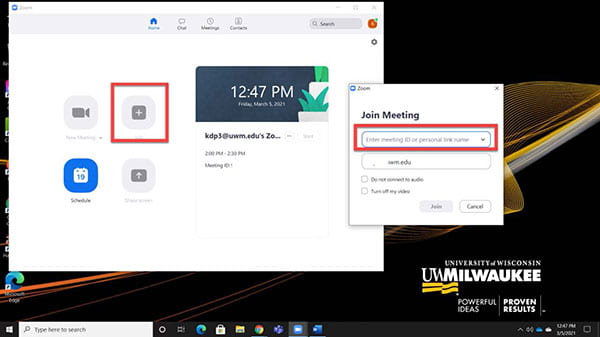
Finally, you can also join by navigating to the UWM Zoom website.
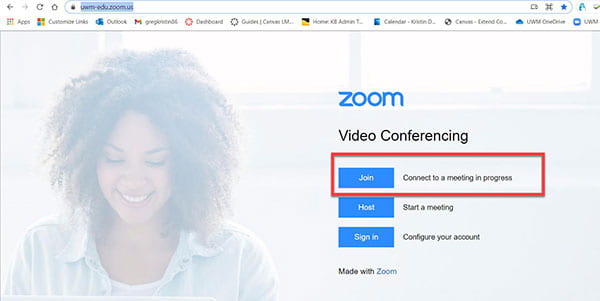
When starting a Zoom meeting that has been set up in your Canvas course, you can enter two ways…
You can enter through the desktop Zoom application by clicking on the ‘Meetings’ button at the top of the screen. Then finding and selecting the course meeting and clicking ‘Start.’
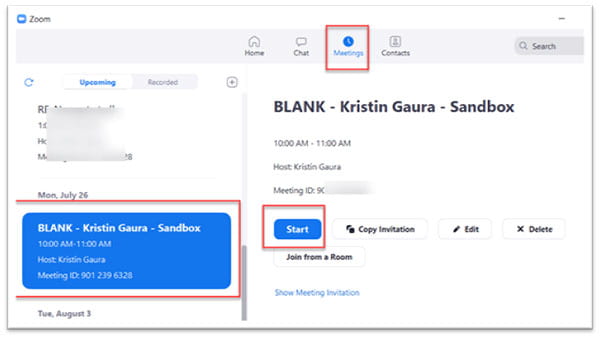
You can also enter through the Canvas course by clicking on the Zoom tab in the Course Navigation, then click on ‘Upcoming Meetings’, then select the meeting and click ‘Start.’

REMEMBER to check your video and audio capabilities. Zoom offers test under the ‘Audio’ icon on the bottom left.

It is important to familiarize yourself with the Zoom interface. (See the Zoom support tutorials here: One Minute Video Introductions)
Practice setting up and testing the audio and video before your meetings. See the video below–Checking Audio and Video Before Your Zoom Meeting–on this page for how-to info.
If you will be showing slides or other information, be sure to practice Zoom’s screen sharing feature. See the video below–Screen Sharing in Zoom–for instructions on how to do this.
NOTE: If using PowerPoint, be sure to have your PPT slideshow file open on the computer/laptop.
Microsoft Teams
UWM faculty, staff, and student all have free access to Microsoft Office 365 Applications (Word, Excel, Teams, etc.). You can use your UWM OneLogin username and password to access Microsoft Office 365 website through UWM by visiting UWM O365.
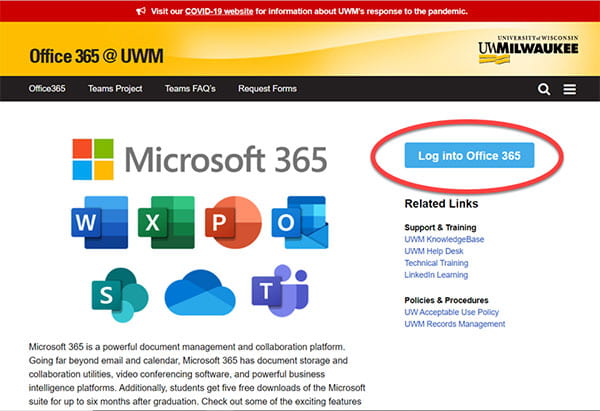
Once logged in, the available Microsoft web version application are listed down the left side (red arrows). If you are interested in using the more robust applications, click the install Office button in the upper right-hand corner (recommended).

When signing onto a meeting, you can either visit your Microsoft Outlook calendar (web version or app) and clicking the ‘Join’ button.
Application Version
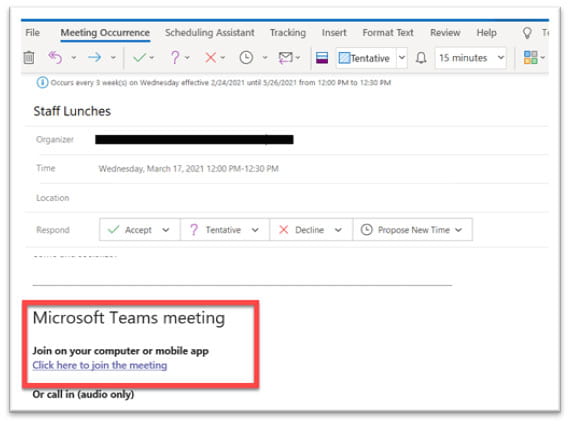
Web Version

Office 365 web vs. application version provides more information regarding the differences between Microsoft Office 365 instances.
REMEMBER to check your video and audio capabilities. Click on the three ‘more option’ dots then ‘Device settings’ to access your Speaker and Microphone selection and volume.
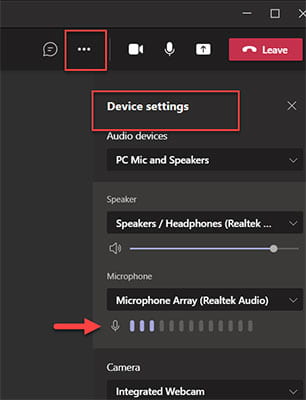
Technology Requirements
If presenting remotely, to provide (and benefit from) the best quality experience, you will need a web camera (webcam), a microphone, and speakers or headphones. Typically, cameras and microphones come built into a lap top; although you may need to add headphones. Headsets (which combine headphones and microphone)—while considered unattractive by some–provide the best sound quality and are highly recommended.
TIP: If you are presenting in a public setting (i.e., a coffee shop, library, etc.) or are in the same room as another meeting participant, the sound quality of your presentation will likely be impacted affecting the success of your presentation.
Videoconferencing can be done via a mobile device. This can be a good choice if you are a meeting participant. It is not a good choice if you are the presenter, however, as you will likely be screen sharing and moving between files (such as PowerPoint), live internet web content, etc. It is very difficult to access these sorts of materials on a small screen.
Support
For assistance contact:
For any Education Technology, online learning, or adult pedagogical questions:
- Kristin Gaura,
kdp3@uwm.edu
(414) 229-4063
Enderis Hall 561
Students should contact their instructors. (Instructors, please refer students to the Video Conferencing Support for Students webpage.
For any questions about computers, software, and other technologies:
- UWM Help Desk
help@uwm.edu
(414) 229-4040
Request Support Webform
For any question regarding Canvas, teaching programs, a range of consultation services, awards and opportunities, technology training and support resources:
- Center for Excellence in Teaching and Learning (CETL)
cetl@uwm.edu
Microsoft Teams